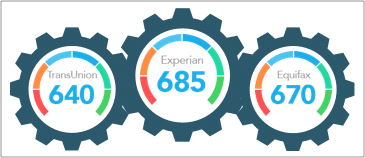Your debt-to-income ratio (DTI) compares your total monthly payments for all of your regular debts to your total monthly income. Lenders use your DTI to help them decide whether you can afford to take on a new loan and whether you’ll be able to make the payments.
Knowing your DTI will help you evaluate your own financial stability and your ability to qualify for a new loan.
What Is Your Debt-to-Income Ratio?
Your debt-to-income ratio (DTI) is the percentage of your monthly income that goes to pay recurring debts. Lenders use your debt to income ratio to assess your ability to manage new debt. A low DTI suggests that you can afford to take on more debt. A high DTI indicates that more debt could stress your ability to pay.
You may hear lenders refer to front-end and back-end DTI. Your front-end DTI is the percentage of your monthly income specifically devoted to housing costs. This is of particular interest to mortgage lenders.
Your back-end DTI includes all of your recurring debts and is used by all types of lenders. Unless a lender refers specifically to front-end DTI you can assume that any reference to debt-to-income ratio is referring to your back-end DTI.
How to Calculate Your Debt-to-Income Ratio
To calculate your debt-to-income ratio you will need to make a list of all of your recurring payments. These types of payments include:
- Rent or Mortgage
- Student Loans
- Personal Loans
- Auto Loans
- Minimum Payments on All Your Credit Cards
- Child Support or Alimony
- Any Other Payments That Show on Your Credit Report
Get a copy of your credit report and make sure you are listing everything on it. If you are paying debts that are not listed on your credit report, include them anyway.
Add the payments on your list together to arrive at your total monthly debt payment. Now combine all your sources of income to arrive at your average monthly income. Use your gross income before taxes and other deductions.
Divide your monthly debt by your total monthly income to get the DTI ratio. To express this as the typical percentage, multiply that number by 100.
For example, if your total monthly debt payments are $2000 and your total gross monthly income is $5000, 2000/5000 is 0.4. Your DTI is 40%.
What Is a Good Debt-to-Income Ratio?
The lower your debt-to-income ratio, the better. Different lenders use different standards to determine whether they are willing to lend to you, but all lenders prefer low DTIs to higher ones..
If your debt to income ratio is high a lender may conclude that you represent a high risk and charge you a higher interest rate than a borrower with a lower DTI. If you are above a lender’s cutoff point they may not lend to you at all.
There are some guideposts to help you determine how your DTI compares to others:
- The Federal Reserve considers a DTI above 40% to be an indication of financial stress.
- Most lenders cannot issue a qualified mortgage to a borrower with a DTI above 43%. Some smaller lenders may be exempt from this rule. Some conventional mortgages backed by Fannie Mae and Freddie Mac may accept DTIs as high as 50%.
- Many lenders who specialize in prime mortgages prefer a DTI under 36%, and a DTI of 36% or lower is generally considered “good”.
- Personal loans, car loans, and other forms of loans usually have less restrictive cutoff points, but they will consider your DTI. A DTI over 50% may make it difficult to get approved for loans.
Many lenders will publish their DTI requirements. If they don’t, ask before applying, especially if your DTI is over 40%. Knowing the lender’s DTI cutoff will help you avoid applying for loans that you will not be able to get.
Knowing your DTI can also help you plan your own finances. If your DTI is over 50% you’re likely to have limited funds for daily needs and you may not be able to cope with unexpected expenses. You may wish to limit new debt and prioritize paying off the debts you have.
How Can I Lower My Debt-to-Income Ratio?
There are two ways to lower your DTI: increase your income or lower your debt.
You can increase your income by asking for a raise or taking on additional work on the side. You can also look for a higher-paying job, but if you’re planning to apply for a mortgage remember that many lenders are also suspicious of rapid job changes.
You can also lower your DTI by paying off some debt. There are several approaches to reducing debt.
- The snowball method involves paying off your smallest debt in full, then moving on to the next smallest. Make only minimum payments on your other debts and use all other resources to pay that smallest debt. Removing a debt completely can help motivate you to take on the next one.
- The avalanche method focuses on the highest-interest debt first. Make only minimum payments on other loans and devote all available resources to paying off your highest-interest debt. When it’s paid, move on to the debt with the next highest interest rate. Removing those high-interest debts will cut your interest expenses.
Any debt reduction strategy will be more effective if you avoid taking on new debt.
If you’re considering a large loan like a mortgage or a car loan, you can lower your DTI by making a concerted effort to pay off old debt and avoid new debt before applying for your new loan.
Does My DTI Affect My Credit?
Your DTI does not directly affect your credit. As long as you are paying all of your debts on time, a high debt load relative to income will not damage your credit. Your income is not a factor in calculating your credit, so any ratio involving income will also not be a factor
The total amount you owe does affect your credit utilization, which is a component of your credit calculation. Credit card debt has a greater impact on credit utilization than it does on DTI, but in general, owing more will increase your credit utilization. Try to keep your credit utilization below 30%, regardless of your DTI.
DTI is a Major Factor in How You Borrow Money
DTI is not the only factor that lenders use to evaluate your loan application. They will also look at your credit score, your credit report, your employment situation, and your income, among other factors.
Your DTI still has a significant impact on your ability to borrow. Lenders will be reluctant to lend to borrowers with a high DTI. They may charge higher interest rates and they may not lend at all.
You can also look at your DTI as a way of determining whether or not you want to apply for a new loan. A high DTI is a sign that you may not be able to take on new credit without the risk of default.
Knowing your DTI and keeping track of how it changes over time will help you determine whether you’re ready for a new loan and what loans you’d qualify for. It’s an important tool for monitoring and evaluating your finances.




